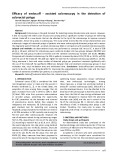
86
Journal of Medicine and Pharmacy, Volume 12, No.07/2022
Clinical, endoscopic, histopathological characteristics of patients
with colorectal polyps - Endoscopy Gastroenterology Center, Hue
University of Medicine and Pharmacy Hospital
Nguyen Van Thu Ha1, Nguyen Phan Hong Ngoc1*
(1) University of Medicine and Pharmacy, Hue University
Background: Colorectal polyps are a relatively common diseases in the group of lower gastrointestinal
tract diseases. The prevalence of colorectal polyps ranges from 20 to 50%. Polyps are formed due to excessive
hyperplasia of the mucosa and the malignancy rate of colorectal polyps is higher than other sites. Objectives:
(1) To describe some clinical and endoscopic features of colorectal polyps; (2) To evaluate the histopathological
characteristics and the relationship between histopathology and some clinical and endoscopic features of
colorectal polyps. Subjects: The patients aged 16 years old and older who were diagnosed with colon polyps
at the Center for Gastroenterology - Endoscopy at Hue University of Medicine and Pharmacy Hospital from
April 1st, 2020 to March 30th, 2021. Methods: Cross-sectional, retrospective description. Results: Study on 67
patients who were dianosiged as having colorectal polyps through endoscopy, in which, 48 patients underwent
polypectomy and histopathology. The mean age is 55.8 ± 15.7 years old, the most common age group is ≥ 45
years old, male/female is 2/1. The time from symptoms onset to disease detection is usually 6 months to less
than 1 year (37.4%). The common clinical symptoms: abdominal pain (83.6%), diarrhea (29.9 %), constipation
(28.4%), dysentery syndrome (13.4%), bloody stools (31.3%). The position of polyps: anus (1.5%), rectum
(47.8%), sigmoid colon (40.3%), descending colon (31.3%), transverse colon (22.4%), ascending colon (28.4) %),
cecum (13.4%). The proportion of patients having ≥ 2 polyps (59.7%), 1 polyp (40.3%). Polyp sizes: 5 - < 10 mm
(50.7%), < 5 mm (37.4%), ≥ 10 mm (11.9%) . The percentage of sessile polyps is higher than that of pedunculated
polyps at each locations. Histopathological types: adenomatous polyps (60.4%), hyperplastic polyps (20.8%),
malignant polyps (4.2%). Polyps with dysplasia (64.6%), mild – grade dysplasia (56.3%), severe-grade dysplasia
(8.3%). The differences were statistically significant between the grade of dysplasia and the polyp size groups,
between the histopathology and the grade of dysplasia (p < 0.05). Conclusions: Colorectal polyps are more
common in patients ≥ 45 years old, male are much more of having than female. Abdominal pain, bloody stools
are common symptoms. Common polyp phenotypes are sessile polyps, ≥ 2 polyps, 5 - < 10 mm in size, mainly in
the rectum. Adenomatous polyps are the most common histopathological type, with the high rate of dysplasia.
Keywords: clinical, endoscopy, histopathology, colorectal polyps.
1. BACKGROUND
Colorectal polyps is a common disease in the
group of diseases at the lower gastrointestinal
tract. The prevalence of colorectal polyps ranges
from 20 to 50%. Polyps are formed due to excessive
hyperplasia of the mucosa and colon polyps has
higher risk of malignancy than other sites, more
than 95% of colorectal cancers are derived from
ductal polyps [1-3]. Clinical symptoms are hidden,
atypical and easily confused with other diseases.
In recent years, flexible endoscopic techniques
play a role in the diagnosis and the endoscopic
polypectomy techniques, histopathological
examination, follow-up after resection, they
reduce colorectal cancer progression and achieve
therapeutic effect [4-6]. We carry out the study
with the purpose of surveying some clinical
characteristics, endoscopy and histopathology of
patients with colorectal polyps.
2. SUBJECTS AND METHODS
2.1. Research subjects
Patients ≥ 16 years old were diagnosed with
colon polyps through endoscopy at the Center
for Gastroenterology - Endoscopy, Hue University
of Medicine and Pharmacy Hospital during the
period from April 1st, 2020 to March 30th, 2021 and
participate in the research.
2.2. Research Methods
2.2.1. Research design
Cross-sectional, retrospective description.
2.2.2. Sample size
Study on 67 patients ≥ 16 years old diagnosed
through endoscopy.
Corresponding author: Nguyen Phan Hong Ngoc, email: nphngoc@huemed-univ.edu.vn
Recieved: 5/11/2022; Accepted: 20/11/2022; Published: 30/12/2022
DOI: 10.34071/jmp.2022.7.12






















